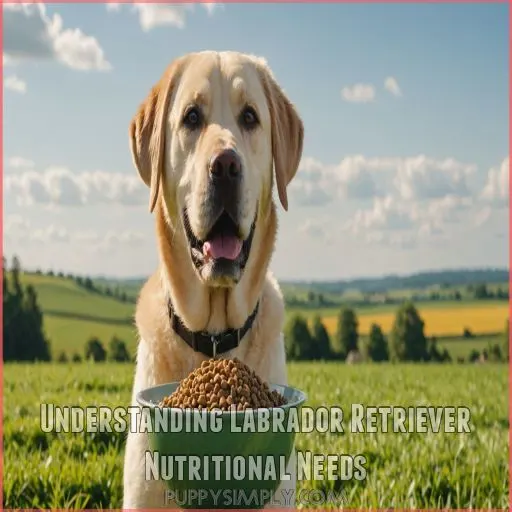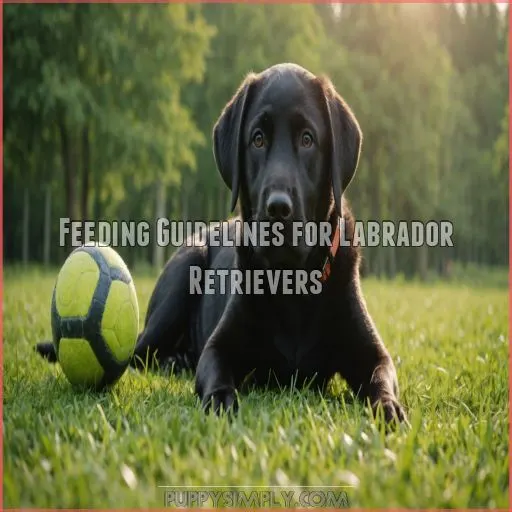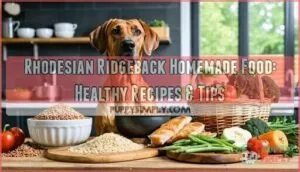This site is supported by our readers. We may earn a commission, at no cost to you, if you purchase through links.

You’ll want to look for high-quality protein sources, balanced fats, and joint-supporting nutrients like glucosamine.
Top picks include Purina Pro Plan for active pups, Hill’s Science Diet for weight management, and Royal Canin’s Labrador-specific formula.
Remember, your Lab’s nutritional needs change with age, so puppies and seniors require specialized diets.
Whether your furry friend is a couch potato or a canine athlete, there’s a perfect food out there.
But wait, there’s more to think about than just brand names…
Table Of Contents
- Key Takeaways
- Understanding Labrador Retriever Nutritional Needs
- Key Features of Quality Lab Dog Food
- 10 Best Dog Food Brands for Labs
- 1. Halo Holistic Chicken and Rice Dog Food
- 2. Large Breed Adult Dog Food
- 3. Purina Pro Plan High Protein Dog Food
- 4. Hills Science Diet Large Breed Senior Dog Food
- 5. Royal Canin Labrador Retriever Adult Dog Food
- 6. Diamond Naturals Chicken Rice Dog Food
- 7. IAMS Adult Large Breed Chicken Dry Dog Food
- 8. Freeze Dried Raw Dog Food Beef
- 9. Honest Kitchen Grain Free Beef Dog Food
- 10. Grain Free Dog Food with Probiotics
- Tailoring Lab Diets to Different Life Stages
- Feeding Guidelines for Labrador Retrievers
- Frequently Asked Questions (FAQs)
- What is the best dog food for dogs?
- What is the best dog food for Labradors in August 2024?
- What is the best type of dog food for a Labrador?
- What is the cheapest dog food for a lab?
- How can I switch to a new food… without getting my Lab sick?
- Do Labs need to eat special dog food?
- What are the 3 feeding stages of a Lab’s life?
- When can I safely switch my Lab puppy to adult food?
- When is my Lab considered a senior?
- What causes hip disease in Labrador retrievers?
- How can I lower my Lab’s risk of hip disease?
- How much food should I feed my Lab?
- What is the best dog food for Labradors?
- What food is good for a labrador?
- What is the best dry food for a lab?
- What is the #1 best dog food?
- How do I transition my Lab to a new food?
- What kibble size is best for Labrador Retrievers?
- Should I be able to see my Labs ribs?
- How often should I feed my adult Labrador Retriever?
- Are there ingredients to avoid in Lab dog food?
- Conclusion
Key Takeaways
- When it comes to your Lab’s nutrition, you’re not just picking up any dog food off the shelf. Focus on high-quality protein sources like chicken or fish, because they’re like the building blocks for strong muscles and a shiny coat that’ll make other dogs green with envy!
- Don’t skimp on healthy fats! They’re your Lab’s secret weapon for boundless energy, a glossy coat that’ll turn heads, and nimble joints ready for fetch marathons. Omega-3s from fish oil are the magic ingredients here, working wonders for both mind and body.
- Joint health in Labs is as crucial as peanut butter is to jelly. Look for dog foods with glucosamine and chondroitin; these are like the mechanics keeping your Lab’s joints running smoothly, especially for those prone to hip or elbow issues.
- Labs have that lovable tendency to pack on the pounds, so watch those portions! Pick foods that offer lower energy density but are rich in nutrients—think of it as a savvy doggy diet plan that doesn’t skimp on the good stuff. Your pup’s waistline will thank you, and so will their hips and heart!
Understanding Labrador Retriever Nutritional Needs
You love your Labrador, but do you know what they really need to thrive?
Understanding your Lab’s unique nutritional requirements is key to keeping them healthy, energetic, and happy for years to come.
Protein Requirements for Muscle Development
Your Lab’s protein needs are important for muscle development.
Typically, adult dogs require a minimum of 18% crude protein in their diet, while puppies need at least 22.5% (Source).
High-quality protein sources help your furry friend:
- Build strong, lean muscles
- Maintain a glossy, healthy coat
- Support a robust immune system
Remember, active Labs and seniors may need more protein to keep their bodies in top shape.
Tailor your pup’s diet to their age, size, and activity level for good health.
Importance of Balanced Fats
While protein builds muscle, fats play a multifaceted role in your Lab’s health.
They’re not just for energy – fats are essential for skin health, joint lubrication, brain function, and puppy growth .
Your furry friend needs the right balance of fats, especially omega-3s from fish oil, to keep their coat glossy and joints nimble .
Think of fats as your Lab’s personal fuel and maintenance crew!
Essential Vitamins and Minerals
Beyond fats, your Lab’s diet should pack a punch with key vitamins and minerals. Vitamin D supports healthy bones and muscles , while calcium is essential for skeletal development.
Don’t forget omega-3s for that lustrous coat!
Glucosamine and chondroitin are the dynamic duo for joint health . Look for chelated minerals in high-quality dry dog foods – they’re like a VIP pass for nutrient absorption. Your pup’s body will thank you!
Calorie Control for Weight Management
Controlling calories is key to keeping your furry friend fit and fabulous.
Tipping the scales too far can be ruff for your Lab!
Opt for lower energy density foods that pack a protein punch while trimming the fat .
Think of it as a doggy diet that doesn’t skimp on nutrition.
Remember, even a few extra pounds can lead to health hiccups, so keep those portions in check .
Joint Health Support Through Nutrition
Your Lab’s joints deserve some TLC, and nutrition plays a big role.
Feeding your furry friend the right food can help keep those hips and elbows in tip-top shape.
- Glucosamine and chondroitin for cartilage support
- Omega-3 fatty acids to reduce inflammation
- Antioxidants to fight free radicals
- Vitamin C for collagen production
- Controlled calories to maintain a healthy weight
Look for dog foods that pack these joint-friendly nutrients .
Your Lab will thank you with every wag and bounce!
Key Features of Quality Lab Dog Food
When you’re looking for the right food for your Lab, not all dog foods are created equal.
Let’s explore the key features that set quality Lab dog food apart, ensuring your furry friend gets the nutrition they need to stay healthy, energetic, and tail-waggingly happy.
High-Quality Protein Sources
What’s the scoop on protein for your Lab?
You’ll want to sniff out high-quality sources like chicken, beef, or fish as the top ingredients in your pup’s chow .
These powerhouse proteins help maintain your Lab’s muscle mass and support their active lifestyle.
Look for dry kibble with at least 22% protein .
Remember, it’s not just about quantity – quality matters to make sure your furry friend gets all the essential amino acids they need.
Omega-3 Fatty Acids for Coat Health
You’ve likely heard about the wonders of omega-3 fatty acids for your Lab’s coat health.
These essential nutrients work magic on your pup’s skin and fur.
Omega-3s support:
- A glossy, head-turning coat that’ll make other dog owners green with envy
- Reduced itching and scratching, letting your Lab focus on more important things (like fetch!)
- A natural barrier against environmental irritants, keeping your pup comfortable year-round
Fish oil supplements or omega-3-rich foods can be your secret weapon for a show-stopping Labrador coat .
Glucosamine and Chondroitin for Joint Support
If you’re looking to keep your Lab’s joints in tip-top shape, glucosamine and chondroitin are the dynamic duo you’ll want in their kibble.
These natural compounds work together to support cartilage health and maintain joint flexibility .
Think of them as your pup’s personal joint mechanics, helping to keep those hips and elbows running smoothly.
For Labs prone to hip or elbow dysplasia, these supplements can be a game-changer in promoting long-term mobility and comfort.
Probiotics for Digestive Health
Keeping your Lab’s digestion on track is a walk in the park with probiotics.
These friendly bacteria are like tiny personal trainers for your pup’s gut, helping to:
- Aid digestion and nutrient absorption
- Reduce gastrointestinal issues like diarrhea
- Support a healthy immune system
Look for dog food brands that include probiotic strains like Lactobacillus and Bifidobacterium.
Your Lab’s tummy will thank you, and you might just notice fewer "oops" moments during your daily strolls!
Antioxidants for Immune System Boost
Boosting your Lab’s immune system is a walk in the park with antioxidant-rich foods.
These powerful nutrients act like tiny superheroes, protecting your pup’s cells from damage .
Look for dog foods packed with colorful fruits and veggies like blueberries, spinach, and sweet potatoes.
These ingredients support immune health, but they also add a tasty twist to your Lab’s meals, keeping their tail wagging and their body thriving.
10 Best Dog Food Brands for Labs
You’ll want to choose the best food for your lovable Lab to keep them healthy and happy.
dog food brands that cater to your Labrador’s unique nutritional needs, from puppyhood through their golden years.
1. Halo Holistic Chicken and Rice Dog Food
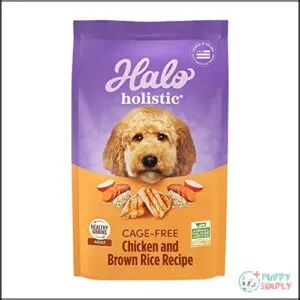
Halo Holistic Chicken and Rice Dog Food stands out as a top choice for your Labrador Retriever, especially if you’re looking for a grain-free food option.
With real, whole chicken as the first ingredient, it’s packed with high-quality protein for muscle development .
You’ll appreciate that it’s made without meat meals, using only cage-free chicken raised without antibiotics.
The balanced blend of omega fatty acids promotes a healthy coat, while prebiotics and probiotics support digestive health like those found in probiotics.
Plus, it’s cooked in the USA with non-GMO ingredients, giving you peace of mind about your pup’s nutrition.
Best For: Labrador Retrievers seeking a high-quality, balanced diet with real chicken and digestive support.
- Made with real, whole chicken as the first ingredient .
- Contains prebiotics, probiotics, and postbiotics for digestive health .
- Cooked in the USA with non-GMO ingredients .
- May not be suitable for dogs that need to lose weight .
- Not grain-free, which may be beneficial for some breeds .
- May increase the quantity of stool produced .
2. Large Breed Adult Dog Food
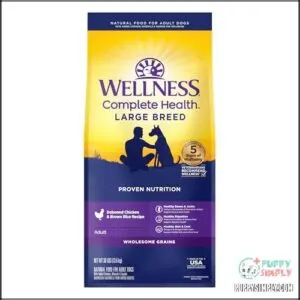
With your Lab’s well-being in mind, let’s talk about the benefits of Large Breed Adult Dog Food.
This kibble is designed to meet your furry friend’s unique nutritional needs.
It’s packed with high-quality chicken and brown rice, providing a wholesome base for your pup’s diet .
You’ll find it’s fortified with glucosamine for joint health and omega fatty acids for a shiny coat.
Plus, it’s free from corn, wheat, and soy – a boon for dogs with sensitivities .
Remember, switching to a new food should be done gradually to avoid tummy troubles.
Best For: Large breed adult dogs, especially those with sensitivities to common ingredients like corn, wheat, and soy.
- High-quality ingredients, including chicken and brown rice .
- Formulated with glucosamine for joint health and omega fatty acids for a shiny coat .
- Free from corn, wheat, and soy, making it suitable for dogs with sensitivities .
- Potential for ingredient changes over time .
- Availability may be subject to supply chain issues .
- Some customers have found success with other brands, such as Wellness .
3. Purina Pro Plan High Protein Dog Food
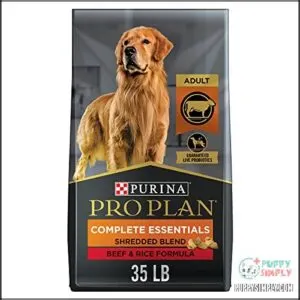
For Labrador Retrievers with high energy needs, Purina Pro Plan High Protein Dog Food is a top contender.
This kibble, featuring real beef as the first ingredient, packs a protein punch to support your Lab’s muscular build .
You’ll appreciate the added probiotics for digestive health, while the omega-6 fatty acids keep your pup’s coat shiny .
Many Lab owners swear by this formula, noting fewer "messes" to clean up – a win for everyone in the household!
Just remember, while it’s a popular choice, every dog is unique. Monitor your Lab’s response and adjust as needed.
Best For: Purina Pro Plan High Protein Dog Food is best for Labrador Retrievers with high energy needs.
- Features real beef as the first ingredient, providing a protein punch for muscular support .
- Contains probiotics for digestive health and omega-6 fatty acids for a shiny coat .
- Many Lab owners report fewer messes with this formula, making it a win for the whole family .
- May not be suitable for all dogs, as individual dietary needs vary .
- Large bag size may be too large for smaller dogs .
- Some customers have reported issues with shipping and delivery, particularly with USPS .
4. Hills Science Diet Large Breed Senior Dog Food
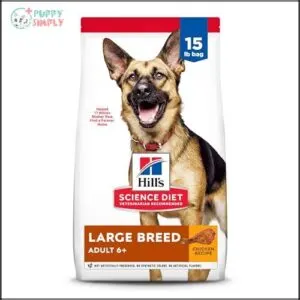
As your Lab enters their golden years, Hill’s Science Diet Large Breed Senior Dog Food steps up to the plate for joint support.
This kibble is designed to support aging joints with natural sources of glucosamine and chondroitin .
You’ll notice your senior pup’s coat gleaming thanks to omega-6 fatty acids and vitamin E.
The high-quality protein promotes lean muscle maintenance, important for older dogs.
Plus, it’s packed with a blend of vitamins, minerals, and natural ingredients like apples and broccoli .
Remember, switching to senior food can be a game-changer for your Lab’s vitality and comfort.
Best For: Hill’s Science Diet Large Breed Senior Dog Food is best for large breed dogs entering their senior years.
- Supports aging joints with natural sources of glucosamine and chondroitin .
- Promotes a healthy coat with omega-6 fatty acids and vitamin E.
- Provides high-quality protein to help maintain lean muscle mass.
- May go stale after halfway through the bag.
- May be necessary to add fish oil or other supplements to encourage eating as the bag gets closer to empty.
- May be cheaper online than in stores.
5. Royal Canin Labrador Retriever Adult Dog Food
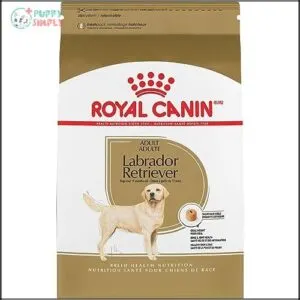
Looking for a breed-specific option? Royal Canin’s Labrador Retriever Adult Dog Food might be your golden ticket. This kibble is tailor-made for Labs 15 months and older, with a unique shape to slow down those enthusiastic eaters .
It’s packed with nutrients to support joint health and maintain that signature Lab coat.
While some owners swear by it for digestive issues and allergies , others argue it’s a bit of a marketing gimmick.
Remember, every pup is unique – consult your vet before making the switch!
Best For: Royal Canin Labrador Retriever Adult Dog Food is best for adult Labrador Retrievers 15 months and older, especially those with digestive issues or allergies.
- Formulated specifically for Labrador Retrievers, addressing their unique needs .
- Helps maintain a healthy weight and supports joint health .
- Many owners report improvements in their Lab’s digestive health and coat condition .
- May not be suitable for other dog breeds .
- Some owners find it expensive compared to other brands .
- May contain ingredients that some dogs are sensitive to .
6. Diamond Naturals Chicken Rice Dog Food
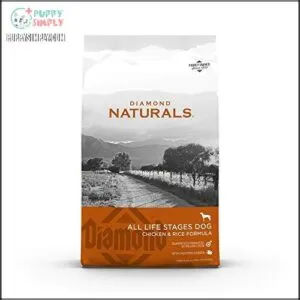
Choosing Diamond Naturals Chicken Rice Dog Food for your Lab might be a game-changer. This brand has won over many dog owners, including those with allergy-prone pups .
Its fresh chicken as the primary ingredient, coupled with whole grain brown rice, provides a balanced diet for your furry friend .
You’ll appreciate the antioxidant formulation and omega fatty acids that promote healthy skin and coat.
Plus, the added DHA supports brain and vision development, while L-carnitine helps convert protein and fat into energy.
With its canine-specific probiotics, this food is a tail-wagging choice for Labs with sensitive stomachs .
Best For: Diamond Naturals Chicken Rice Dog Food is best for Labrador Retrievers with sensitive stomachs, allergies to corn, or who tend to gain weight easily.
- Fresh chicken as the first ingredient provides a balanced diet.
- Antioxidant formulation and omega fatty acids promote healthy skin and coat.
- Canine-specific probiotics help maintain a healthy digestive system.
- Some users reported initial refusal by their dogs, possibly due to treats during transition.
- Past recalls involving aflatoxin contamination in some formulas raised concerns.
- Price can fluctuate on Amazon, so waiting for lower prices may be beneficial.
7. IAMS Adult Large Breed Chicken Dry Dog Food
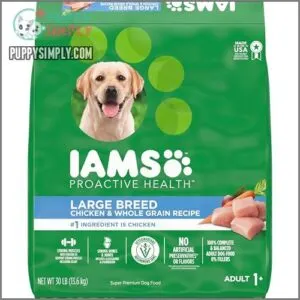
With IAMS Adult Large Breed Chicken Dry Dog Food, your Labrador Retriever gets a well-rounded meal.
It’s packed with protein from chicken and eggs, helping build those strong muscles Labs are known for .
The formula includes targeted calcium for joint health and omega-3 DHA to support cognitive function .
Plus, it’s enriched with antioxidants to boost your pup’s immune system.
While some dogs may have trouble adjusting to new foods , many Lab owners find IAMS to be a reliable choice.
Just remember, every dog is unique – monitor your furry friend’s response and consult your vet if you have concerns.
Best For: IAMS Adult Large Breed Chicken Dry Dog Food is best for larger breed adult dogs needing a balanced diet with protein for muscle development and joint support.
- Contains protein from chicken and eggs for strong muscles .
- Includes targeted calcium for joint health .
- Enriched with antioxidants to support the immune system .
- Some customers reported difficulty adjusting to the food .
- Kibble size may be large for smaller dogs .
- The bag may not be resealable .
8. Freeze Dried Raw Dog Food Beef
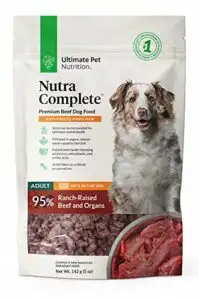 View On Amazon
View On Amazon A rising star in the canine nutrition world, Nutra Complete Freeze Dried Raw Dog Food Beef packs a protein punch for your Lab.
This veterinarian-developed formula boasts 95% ranch-raised beef and organs, delivering easily digestible nutrients (Source).
It’s not just about the meat, though. Seeds, fruits, and veggies round out the nutritional profile, supporting everything from digestion to immune function.
While some pet parents might balk at the price tag, many report seeing improvements in their pups’ energy levels and coat health.
Just remember to soften it up before serving – your Lab’s tail will be wagging in no time!
Best For: Nutra Complete Freeze Dried Raw Dog Food Beef is best for pet owners looking for a high-quality, protein-rich option for their active dogs.
- It contains 95% ranch-raised beef and organs, providing easily digestible protein.
- It includes seeds, fruits, and vegetables for added nutrients.
- It is designed to support healthy digestion, a thick coat, immune function, and overall health.
- It can be expensive compared to other dog food options.
- You may need to soften the product before feeding.
- It may not be suitable for dogs with beef sensitivities.
9. Honest Kitchen Grain Free Beef Dog Food
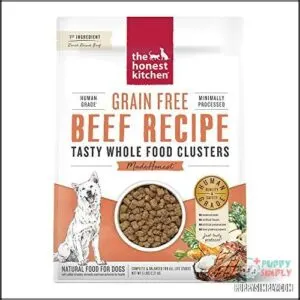
Honest Kitchen’s Grain Free Beef Dog Food is a great choice for your Lab’s nutrition.
This human-grade dehydrated food boasts a superior ingredient list, including dehydrated beef as the primary protein source .
It’s packed with nutrient-rich fruits and veggies like sweet potatoes, apples, and pumpkin, providing a well-rounded diet.
The food’s low-temperature processing preserves more natural nutrients, giving your pup a taste of home-cooked goodness.
Plus, with its FDA approval as human-grade, you can rest easy knowing you’re feeding your furry friend the crème de la crème of canine cuisine.
Best For: Honest Kitchen’s Grain Free Beef Dog Food is best for dog owners looking for a human-grade, dehydrated dog food with a high-quality ingredient list.
- Human Grade: This food is made with 100% human-grade ingredients and produced in a human food facility.
- Nutrient-Rich: Honest Kitchen’s Grain Free Beef Dog Food is packed with nutrient-rich fruits and veggies like sweet potatoes, apples, and pumpkin, providing a well-rounded diet.
- Minimally Processed: The low-temperature processing preserves more natural nutrients, giving your pup a taste of home-cooked goodness.
- Large Kibble: Some customers report the kibble is too large or crumbly.
- Limited Meat Visibility: Some feel that the meat content is hidden by grinding it into powder, making it difficult to see the actual amount of meat.
- Potential for Need for Supplements: Some users report needing to add homemade broth or meat to the food to make their dog eat it, like adding cooked pork.
10. Grain Free Dog Food with Probiotics
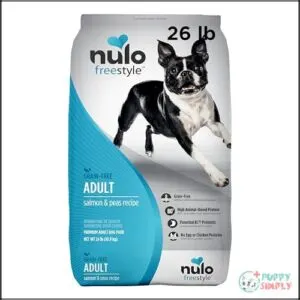
Nulo Freestyle Adult Dog Food Salmon & Peas offers a grain-free option packed with probiotics for your Lab’s digestive health.
You’ll find a high-protein formula (30% minimum) that supports muscle development and maintenance .
The blend of omega-3 and omega-6 fatty acids promotes a healthy coat, while added vitamins and minerals boost overall wellness.
Your pup will love the deboned salmon and turkey flavors, and you’ll appreciate the absence of artificial additives .
Remember to adjust portion sizes based on your Lab’s activity level to maintain a healthy weight.
It’s a tail-wagging choice for your furry friend!
Best For: Nulo Freestyle Adult Dog Food Salmon & Peas is best for active dogs who need a high-protein, grain-free diet with added probiotics to support their digestive health.
- Grain-free: This formula is free of grains like corn, wheat, and soy, which can cause digestive issues in some dogs .
- High Protein: With a minimum of 30% protein, this food helps support muscle development and maintenance .
- Probiotic-Enriched: Contains GanedenBC30 probiotics to promote healthy digestion .
- Strong Salmon Smell: Some customers have reported a strong salmon odor with this food .
- Palatability Issues: Some dogs may not like the taste of this food .
- Packaging and Shipping Concerns: Some customers have experienced damaged bags due to issues with Amazon’s packaging and shipping .
Tailoring Lab Diets to Different Life Stages
You’ll need to adjust your Lab’s diet as they grow from a bouncy pup to a distinguished senior.
Let’s explore how to tailor your furry friend’s meals to meet their changing nutritional needs at every stage of life.
Puppy Nutrition for Optimal Growth
Nurturing your Lab puppy’s growth is a delicate balancing act.
You’ll want to feed them a specially formulated large-breed puppy food until they’re about 12 months old .
This important period sets the stage for their lifelong health.
Stick to a consistent feeding schedule and portion control to avoid overfeeding.
Remember, those puppy eyes are adorable, but extra treats can lead to weight issues down the road!
Adult Lab Dietary Requirements
Keeping your adult Lab’s tail wagging starts with the right diet.
Your furry friend needs a balanced mix of nutrients, including protein for muscle maintenance and fats for energy.
Aim for about 0.36 grams of protein per 100 grams of dry food .
Don’t forget to factor in your Lab’s activity level and any food sensitivities when choosing between kibble or wet options.
Remember, a well-fed Lab is a happy Lab!
Senior Lab Nutritional Considerations
As your Lab enters their golden years, their nutritional needs shift.
You’ll want to focus on:
- Weight management to ease joint stress (Source)
- Omega-3 fatty acids for cognitive function
- Lower sodium for heart and kidney health
- Higher-quality protein to maintain muscle mass
Remember, your senior pup’s metabolism is slowing down. It’s like they’ve switched from sports car to luxury sedan – still running smoothly, but needing premium fuel to keep the engine purring.
Adjusting Diets for Active Vs. Sedentary Labs
Your Lab’s energy needs can vary dramatically based on their activity level.
Just like you’d fuel up differently for a marathon versus a day on the couch, your pup’s diet should match their lifestyle.
Let’s look at how to tailor your Lab’s meals:
| Activity Level | Calorie Adjustment | Food Choices |
|---|---|---|
| Couch Potato | Reduce by 20-30% | Low-fat options |
| Weekend Warrior | Maintain baseline | Balanced nutrition |
| Canine Athlete | Increase by 20-40% | High-protein, energy-dense |
Remember, these are starting points.
You’ll need to monitor your Lab’s weight and adjust accordingly .
Special Diets for Labs With Health Issues
While active Labs need more calories, those with health issues require special diets.
If your Lab has allergies, consider grain-free options .
For hip dysplasia, foods rich in glucosamine and chondroitin can support joint health .
Overweight pups? Opt for weight management formulas .
Don’t forget digestive health – probiotics can work wonders.
Remember, a customized diet can make a world of difference in managing your Lab’s specific health challenges.
Feeding Guidelines for Labrador Retrievers
Feeding your Labrador Retriever isn’t just about filling their bowl—it’s about nourishing their body and soul.
Portion sizes and the debate between kibble and canned food are just a few things to consider when feeding your Lab.
We’ve got the scoop on how to keep your Lab’s tail wagging at mealtime.
Portion Control and Feeding Frequency
For feeding your Labrador, portion control is the name of the game.
You’ll want to measure your pup’s food carefully to avoid overfeeding, which can lead to obesity and health issues .
Aim for at least two meals a day, spaced about 12 hours apart .
This schedule helps prevent nausea from an overly acidic stomach and keeps your Lab’s energy levels steady throughout the day.
Wet Vs. Dry Food Considerations
Now that we’ve covered portion control, let’s chew on the wet vs. dry food debate for your Lab.
Kibble’s a breeze to serve and store, plus it’s budget-friendly .
But canned food? It’s like a gourmet meal for your pup, packed with moisture and irresistible flavors.
Some Labs prefer the crunch of kibble, while others drool over wet food’s texture.
Mix it up to keep mealtime exciting and boost hydration!
Addressing Common Feeding Issues in Labs
Let’s tackle some common Lab feeding hurdles.
Is your furry friend turning their nose up at dinner? You’re not alone! Labs are notorious chow hounds, but they can be picky too.
Food allergies might be the culprit behind that scratching .
Keep an eye on your Lab’s weight – obesity is a major health risk for these food-loving pups .
And don’t forget joint supplements for those active joints!
Transitioning Between Different Dog Foods
Switching your Lab’s chow doesn’t have to be a doggie drama.
You’ll want to take it slow to avoid any tummy troubles.
- Days 1-3: Mix 20% new food with 80% old food
- Days 4-6: Go 50/50 with new and old
- Days 7-9: Bump up to 80% new food, 20% old
- Day 10: Voilà! You’re fully switched over
Remember, if you’re just changing protein sources in the same brand, you can usually do it overnight .
Monitoring and Adjusting Diet for Optimal Health
Keeping a watchful eye on your Lab’s health is important.
You’ll need to monitor their weight, energy levels, and overall well-being to make sure their diet is on point.
| Factor | What to Watch | How to Adjust |
|---|---|---|
| Weight | Body condition | Adjust portion sizes |
| Energy | Activity level | Increase/decrease calories |
| Coat | Shine and texture | Add omega-3 fatty acids |
| Digestion | Stool consistency | Try probiotics or fiber |
| Hydration | Water intake | Ensure fresh water available |
Remember, your Lab’s dietary needs may change over time, so stay flexible and consult your vet regularly.
Frequently Asked Questions (FAQs)
What is the best dog food for dogs?
For the best dog food, consider Purina Pro Plan for well-rounded nutrition that suits various breeds and life stages.
It provides balanced nutrients, supports digestive health, and offers options for specific dietary needs .
What is the best dog food for Labradors in August 2024?
To choose the best dog food for Labradors, consider a balanced diet with high-quality protein, healthy fats, and whole grains.
Brands that meet these needs are often recommended by veterinarians and Labrador breeders .
What is the best type of dog food for a Labrador?
Finding the right dog food for Labradors is like hitting the nail on the head.
Grain-inclusive options like Blue Buffalo Wilderness provide balanced nutrition, reducing the risk of hip disease with proper calcium levels .
What is the cheapest dog food for a lab?
You might try affordable brands like Purina One or Hill’s Ideal Balance, which provide balanced nutrition for Labs without breaking the bank.
You’re giving your furry friend both love and good health—it’s a win-win! .
How can I switch to a new food… without getting my Lab sick?
Switching your Lab’s food without a hitch is like conducting a symphony.
Start with 25% new food, slowly increasing to 75% over nine days.
Keep tabs on belly rumbles and consult your vet if things go awry .
Do Labs need to eat special dog food?
Labs, especially as puppies, need dog food designed for large breeds to support healthy growth and minimize joint issues.
Hip dysplasia can be caused by too much calcium or overfeeding, so choose wisely for your furry friend .
What are the 3 feeding stages of a Lab’s life?
Labrador Retrievers need specific nutrition during three feeding stages: puppyhood, adulthood, and senior years.
Puppies require growth-focused diets, adults benefit from balanced maintenance food, and seniors thrive on lower-calorie, joint-supportive formulas.
Following these stages helps keep your dog in tip-top shape.
When can I safely switch my Lab puppy to adult food?
Your Labrador puppy can switch to adult food between 12 to 18 months.
This timing supports their growth and joint health, ensuring slow, steady development.
Consult your vet for personalized advice that suits your pup best .
When is my Lab considered a senior?
Your Labrador is considered a senior around 7-9 years old, depending on their size and overall health.
This stage requires a bit more care, so give them extra love, comfy bedding, and regular vet check-ups .
What causes hip disease in Labrador retrievers?
Hip dysplasia in Labradors often stems from their genetic makeup, like a hidden family heirloom you didn’t want.
Rapid growth, obesity, an unbalanced diet, and certain environmental conditions can worsen the condition .
How can I lower my Lab’s risk of hip disease?
To lower your Lab’s risk of hip disease, keep them lean, provide a balanced diet, and make sure they get regular exercise.
Consult with a vet for personalized nutrition advice and consider joint supplements to support their health .
How much food should I feed my Lab?
Feed your Labrador 2-4 cups of high-quality kibble daily, adjusted for activity level and weight.
Labs love food, so watch for overindulgence.
Check ribs to make sure a healthy weight; you should easily feel them but not see them .
What is the best dog food for Labradors?
Choose a high-quality dog food with real meat as the first ingredient for your Labrador.
Brands like Blue Buffalo Wilderness and Purina Pro Plan offer nutrient-rich options to support your lab’s energetic lifestyle and joint health .
What food is good for a labrador?
For your Labrador, you’ll want a dog food that’s made for their large breed needs.
One with the right balance of protein, fat, and calcium to support their growth and joint health.
What is the best dry food for a lab?
Blast from the past: Blue Buffalo Wilderness offers balanced nutrition with protein-rich chicken for your Labrador’s muscle mass needs.
Healthy fats and watch your furry friend strut with a glossy coat and strong joints .
What is the #1 best dog food?
Picking the best dog food is like finding the Holy Grail—everyone’s quest is unique!
Consider your dog’s needs, but options like Blue Buffalo Wilderness and Zignature come highly recommended for their balanced nutrition and allergy-friendly formulas .
How do I transition my Lab to a new food?
Switch your Lab to new food slowly over 7-10 days.
Start with 25% new and 75% old food.
Gradually increase the new food portion every few days.
Keep an eye on digestion for any issues .
What kibble size is best for Labrador Retrievers?
Choose a kibble size similar to a pea or dime for your Labrador Retriever.
This size supports dental health and is easy for Labs to chew and swallow,
ensuring they enjoy their meals without struggle.
Should I be able to see my Labs ribs?
In a healthy Lab, you should see ribs only when they stretch or twist, not when standing still. This indicates being well-toned without extra fat, similar to a fit athlete .
How often should I feed my adult Labrador Retriever?
Feed your adult Labrador twice a day—once in the morning and again in the evening.
This approach balances their boundless energy, helps curb that trademark Labs’ appetite, and supports a healthy weight .
Are there ingredients to avoid in Lab dog food?
Steer clear of ingredients like artificial colors, flavors, and preservatives in your Labrador’s food. Focus on whole, natural ingredients like meat, veggies, and healthy fats for a balanced diet.
Conclusion
Think of your Lab’s diet as the key to boosting their energy levels—a treasure chest for boundless energy and long-lasting health.
Choosing the best dog food brands for Labs involves understanding their unique nutritional needs.
With balanced diets that support everything from joint health to a shiny coat, you’re set to fuel your furry friend’s adventures.
Remember, a happy Lab is a well-fed Lab, and their loyalty is the reward you’ll cherish every day.

